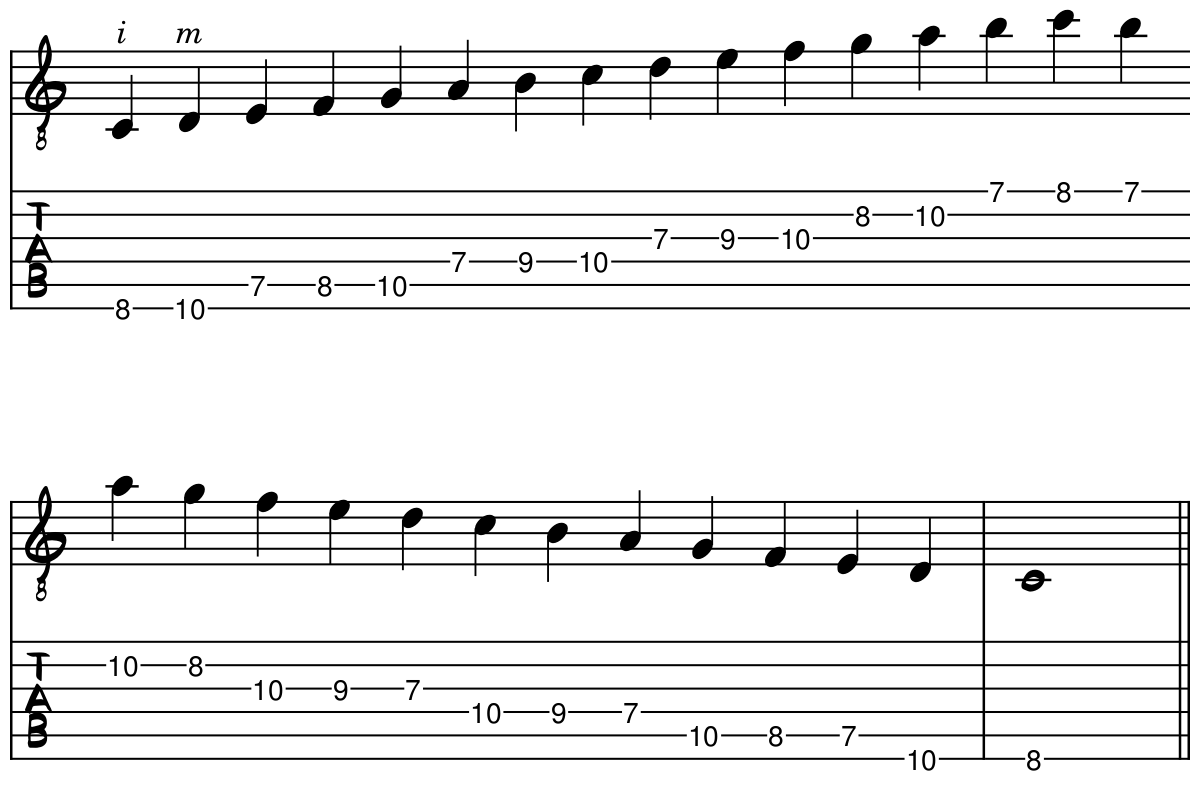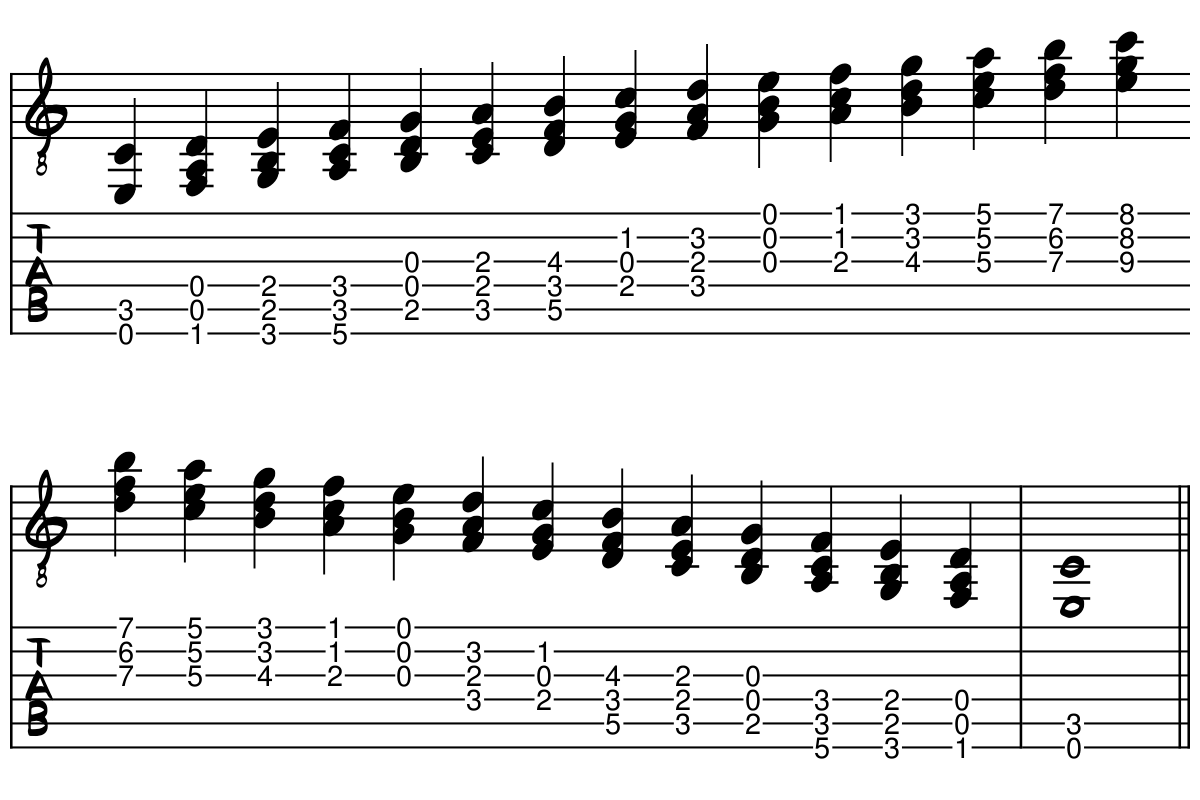Here is your ultimate guide to playing scales with fingerstyle guitar as well as common fingerpicking patterns.
Are you looking for exercises which are ways to play scales fingerstyle instead of using a pick? In fact, there are several ways that you can play scales fingerstyle, from using repeated notes to playing multiple notes in the scale simultaneously.
For this article, we will use the C Major scale for all of our examples, although these patterns will work well with any scale.
I'll share with you the 5 fun ways you can play scales that are unique to fingerstyle guitar.
How To Play Fingerstyle Scales
Before we get started learning different ways to play fingerstyle scales, we're going to start with the proper technique to playing scales as a fingerpicker.
To play fingerstyle guitar scales effectively, you will need to use walking fingers with the plucking hand, combined with a consistent fretting hand finger pattern. The choice of finger pattern that you use will depend on the scale you choose to play, as well as the range.
You can play any scale on the guitar in first position, using open strings when possible. However, you need to know the names and positions of the notes that are in your scale in order to play it in first position.
Ascending and Descending Scales
This approach is the way most guitarists play scales, using the two octave pattern, ascending (going up) and descending (going down). By using this pattern, you can move up and down the guitar neck and play in any key without having to know what the notes are.
Here's the C Major scale starting from the eighth fret, ascending and descending over 2 octaves.

Normally, when you pluck repeated notes, you'll want to avoid using the same finger to pluck the same string twice in a row. This is avoided by using a technique called walking fingers.
Now that we know exactly how to play the C major scale normally, let's look at some exercises you can use to play scales instead of the normal ascending and descending patterns.
1. Eighth Note Tremolando Scales
One fun aspect of fingerstyle guitar is the ability to play tremolando scales. A tremolando scale involves rapidly alternating between two or more notes on the same string or, more rarely, on adjacent strings.
In fingerstyle guitar, you can play combinations of two, three or four notes as you play tremolando scales. Actually, you can play higher numbered combinations but I find that unnecessary.
Here is the C major scale over two octaves, like we saw before, but now we will repeat each note twice. For this scale pattern, you can use a combination of i and m, m and a, or i and a fingers.

2. Triplet Tremolando Scales
If you thought that the eighth note tremolando scale was too slow for your taste, luckily there's a way for us to add more notes with the triplet tremolando scale. The triplet tremolando scale is a fingerstyle guitar technique where you play three repeated notes per beat. You use the same 2 octave finger pattern, but now each note gets played as a triplet—you must play each note 3 times per beat.
To play triplet tremolando scales smoothly, I like to use a combination of p-i-m, i-m-a, a-m-i or m-i-p finger patterns to play these scales.

3. Sixteenth Note Tremolando Scales
If you feel like doing the ultimate fingerstyle workout, you can kick it up a notch to sixteenth notes. When playing the tremolando scale using sixteenth notes, each beat is divided into four equal parts, allowing for a quick succession of notes.
Thus, the sixteenth note tremolando scale involves playing the same note four times in a row, very quickly, before moving on to the next note in the scale.

As you practice the scale, focus on maintaining a steady rhythm and fluid motion with your right hand. The goal is to achieve a smooth and seamless transition between notes, creating a sense of flow and continuity in your playing
Experiment using combinations of all four of your right hand fingers. For example, you can try p,i,m,a or p,a,m,i or a,m,i,p.
4. Contrary Motion Scales
The best way to improve finger independence and coordination between both the fretting and the plucking hand in guitar is to play scales in contrary motion.
When you play scales in this manner, you are forced to place the fingers exactly in the right spot on the fretboard.
Here is the C Major scale in contrary motion. The top line starts at the note C and does a descending pattern, whereas the bottom line starts from low C and does an ascending pattern.

When playing contrary motion scales, you'll want to pay special attention to how your fingers must stretch differently, depending on which note you are playing in the scale pattern. This is to avoid sloppy playing and prevent buzzing.
5. Chordal Scales
Chordal scales are a unique and beautiful way to practice scales and harmony at the same time. With a chordal scale, you'll want to play first inversion chords for every degree in the scale. This is also known as harmonizing the major scale.
Here's what the 2 octave C major scale looks like in chordal version.

How To Practice Fingerstyle Guitar Scales
When practicing finger picking guitar scales, be sure to play the scale slowly and place great emphasis on finger placement and accuracy. The goal isn't speed, but proper technique when playing fingerstyle scales.
Your intention should be on coordinating both your fretting hand and your plucking hand. Use scales as an opportunity to improve finger accuracy and tone for fingerstyle guitar.
You can practice all of these scale patterns as a warm up.
How To Play Scales If You Have Small Hands
The problem with the three-note-per-string fingering pattern of the major scale is the wide stretches between notes. It's possible to play the major scale using only two or four note per string patterns. However, you may have to sacrifice speed and ease of memorization
If you have small hands and still want to use the three note per string pattern, you can practice the major scale in higher positions, where the frets are closer together.
For instance, you could play the C Major scale, starting from the 8th fret instead of the G major scale which starts at the 3rd fret. Instead of trying to stretch your fingers, play a scale in a higher position.
How To Increase The Speed of Your Fingerstyle Guitar Scales
To play scales faster with fingerstyle guitar, you must practice with a metronome. Play the scale slowly and be very precise with how you place your fingers.
Try to increase the speed of your scale by incrementally increasing the BPMs on your metronome. Keep track of your progress in a practice log and make this part of your warm-up routine.
If you are still looking for more fingerstyle guitar exercises, there are lots of songs you can play in the course Play Fingerstyle Guitar Now!



